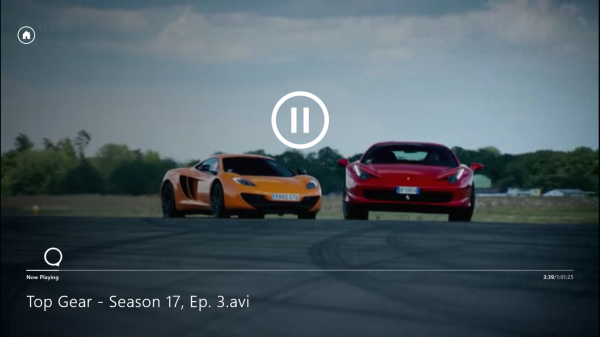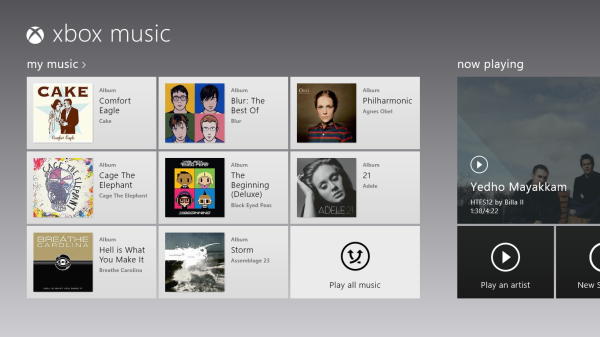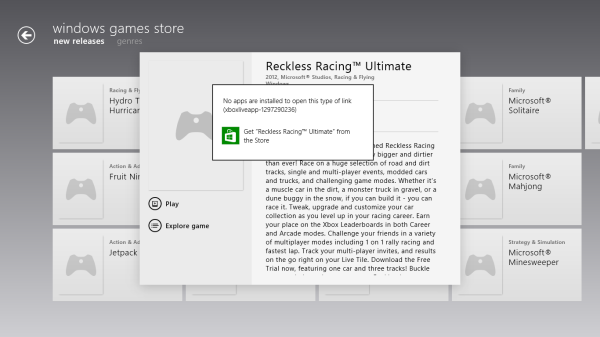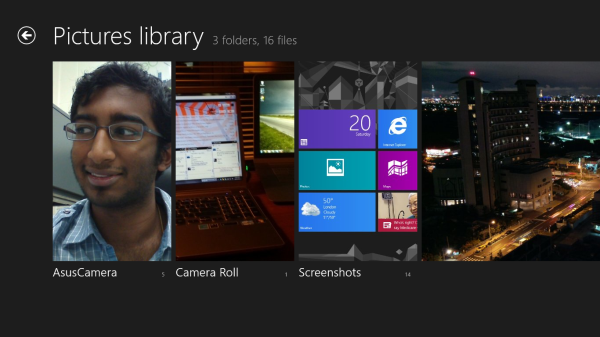The Windows RT Review
by Vivek Gowri & Anand Lal Shimpi on October 25, 2012 12:00 PM EST- Posted in
- Windows RT
- Operating Systems
- Microsoft
- Mobile
- Windows 8
- Tablets
Xbox Live: Music, Video, and Gaming
The music and video players are now part of the Xbox Live family of services, so they’re connected to Xbox Music and Xbox Video respectively. The applications are separate but are very similarly designed and laid out, with local content on the left, featured content in a central location, and content stores to the right. The bottom edge swipe brings up the ability to specify a file for playback, as well as a now-playing control bar. The music application looks quite good when snapped to the edge, with various album art from your library appearing as the background for the music controls.
Hilariously, videos can also be played back when snapped, albeit in a very small window. It’s not the best way to watch a video (who enjoys watching video content in a 320x180 window? Anyone? No takers?) but you can do it if you really want to. The video playback controls are pretty elegant in full-screen mode, and both players seem to have taken a number of interface design cues from the Zune software. I’m a huge fan of the Zune desktop software and how elegantly it operates, so I think this is great. I’m also just glad to not have to deal with Windows Media Player.
Both Xbox Music and Xbox Video look very similar to the latest Xbox dashboard update, and it’s clear that Microsoft is pushing a unified entertainment content front here. I remember when Microsoft was supporting a half dozen different music stores when the original Zune launched in 2006, so I’m just glad that they’re finally consolidating all of their services and concentrating on a single content store. Xbox has been their most successful entertainment effort to date, so it’s no surprise to see Microsoft put their faith in it for media as well.
Now, we can’t discuss Xbox without touching on gaming. Xbox Live is obviously the gaming portal of choice for Windows RT, and offers various hubs for Windows and Xbox 360 games. The Xbox Live application didn’t appear to be ready at the time of posting, with broken links and missing pictures for all the games and hubs. This is still an unreleased software (until Friday, anyways) so it’s possible that we’ll see the application be updated between now and then for a working final release. We will also have to wait until then to see what game support will be like out of the box; currently, the Xbox Windows Game store shows titles like Reckless Racing, Hydro Thunder Hurricane, Fruit Ninja, Cut the Rope, and a number of Microsoft classic titles like Minesweeper and Solitaire, amongst others.
Camera and Photos
The camera application is about as basic as you can get, with a translucent control bar that lets you switch cameras, change between still and video capture modes, set up a timer, and basic picture quality settings. Basic isn’t necessarily a bad thing though, as the application operates smoothly and quickly, with near-instant switching between modes and cameras. The controls are very straightforward - tap and hold to lock exposure is supported, and to capture an image you can just tap anywhere on the screen. It’s one of the easiest capture mechanisms out there, and fits right in with the simple UI.
The photo application pulls images from your local pictures folder and camera roll, as well as being able to connect to Facebook, Flickr, and SkyDrive. They show up as panels for each service, which show a full list of thumbnails. It’s worth pointing out that you can only see photos uploaded to Facebook from your own account, not friend’s images or pictures you’ve been tagged in. As is now the norm with tablet picture galleries, you can view images in slideshow form or just flick through them individually. For local images, the bottom edge swipe brings up an option to delete the images, as well as setting as the lockscreen image and starting a slideshow. For images on Facebook, there’s an option to view them in Facebook, though you need to actually be signed into Facebook in IE for this to work.
The overall takeaway from the camera and gallery applications is that they’re designed as minimally as possible and do exactly what they’re supposed to with a minimum of fuss. You won’t see any spectacular functionality, though the ability to slideshow through Facebook galleries is a nice touch. I think we’ll see manufacturers offer their own spin on these applications, like ASUS and their separate camera application, in an attempt to gain minor levels of platform differentiation. Microsoft has kept a pretty tight reign on the customizations allowed for the Windows Phone platform though, so I can’t see them allowing anything too invasive on Windows RT devices either.















233 Comments
View All Comments
steven75 - Friday, November 2, 2012 - link
Yes, agreed 100%. This review seems to be by far the most certain the *metro* apps are going to grow by leaps and bounds than any other review I've read. I think there's definitely a chance RT and thus metro apps aren't going to take off at all.karasaj - Thursday, October 25, 2012 - link
Forgot to say thanks, great review! I was wondering about the smoothness of Surface etc - it doesn't seem like there will be much to worry about. Thanks again!nedjinski - Thursday, October 25, 2012 - link
Thanks for yet another sane and unbiased review. I find this approach the most helpful when considering a new purchase. You guys continue to have clear vision when it comes to the big picture and you don't get distracted by small details that will probably get ironed out in future iterations of the device.It looks like MS has a winner here.
Netscorer - Thursday, October 25, 2012 - link
While this is an overall very good and comprehensive review, I am still confused by two separate Windows 8 OS (with Windows Mobile 8 may be third). I just don't see how they are going to coexist long term. And if there will be convergence, which OS will be left out.I was hoping review would touch on those issues a bit more then spending page after page describing various apps that come built in and will undergo a significant change/enhancement shortly anyway.
haukionkannel - Thursday, October 25, 2012 - link
Well the Metro UI aplication will be very popular in Mobile platforms. Because both windows 8 versions can run those, there is no problem in there. If you want to run normal desktop application, video editing, AAA games, the normal 86 version of win8 is for you.If you have to chose between normal win8 and win8 RT pad, or tablet there is not very big difference. In most cases it is better for programmers to make Moder UI version of their program than to make only Intel CPU based version that runs only in normal win8 version. Thre will be more customers in Modern UI platform than normal. So instead of having bottle neck with old gaming consoles, the new botleneck will be the slovest win8 RT pad in most cases.
If you are serious gamer the normal win8 is for you. If you are interested in just getting pad for playing casual games like Angry bird, and reading www-pages, listening music, looking viodeos, etc, it does not matter what you get, if the price is good and ahrdware desent.
AmdInside - Thursday, October 25, 2012 - link
Waiting for MAME to be available for either Windows RT or Windows 8 before I buy a tablet.ludikraut - Thursday, October 25, 2012 - link
Oh yeah, MAME on a tablet will rock.l8r)
jecastejon - Thursday, October 25, 2012 - link
I am interested, reading and taking notes but is this Windows RT a netbook-nettop OS at a higher price point?I think I will wait at least 2-4 years to consider an ARM-Atom based computer to produce even some light work, as for a device to have fun there are tablets, Nintendo, PSP, iDevices with thousands of apps or games. WRT is not that cool, it does nothing better as an entertaining system but it may be great to produce very light or limited work on the office and just probably on the go but even for that it will need to compete with entry-laptops and ultralight machines.
Right now this is a very hybrid concept targeting for a broad marked but I just can see a niche market I am sure it will reach. I think in part the price is to high and it will be kind of a business ultra light high end system.
diamondsw2 - Thursday, October 25, 2012 - link
"85% (or more) of computers being sold worldwide"I assume you're not including iPad sales - which is very misleading for a tablet OS review. And if you're more broadly talking Windows 8 all of a sudden (RT != 8), the overwhelming majority of Windows sales are to businesses - and those businesses are going to exercise their downgrade rights and not touch Windows 8 with a ten-foot pole. There's no business case for it over Windows 7, and the training is far from insignificant. It's not going to get any headway there for years.
Consider be very skeptical on actual uptake of Windows 8 or its supposed marketshare. I'll bet it's six months to a year before I see the first person using it (which may say more about how many of my PC-using friends have converted to iPads and Macs). I fully expect every Windows PC I see to be on 7 for a long time to come).
PsychoPif - Thursday, October 25, 2012 - link
Just from a quick search, I've found that Apple sold 15.4m IPad vs 49.8m for the top 4 OEM. It does'nt include the other manufacturer and it's still 70% marketshare.85% might be high, but don't make it sound like Windows won't be on the vast majority of computer sold this year.